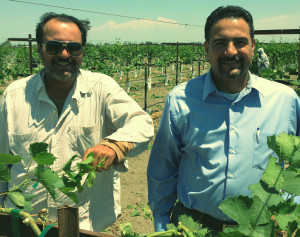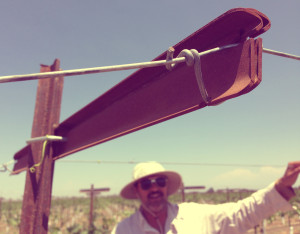 Harinder and Ravinder (Bobby) Dhaliwal told me that for them, growing winegrapes is a “hobby”. I spoke with the brothers over lunch one day in July, and it quickly became clear that they are definitely not hobby farmers. Modest and hardworking most accurately describe these two. In addition to full-time, off-farm careers, the brothers and their extended family farm over 1,000 acres of winegrapes and are serious, savvy, and innovative winegrowers with a long-term vision for their business.
Harinder and Ravinder (Bobby) Dhaliwal told me that for them, growing winegrapes is a “hobby”. I spoke with the brothers over lunch one day in July, and it quickly became clear that they are definitely not hobby farmers. Modest and hardworking most accurately describe these two. In addition to full-time, off-farm careers, the brothers and their extended family farm over 1,000 acres of winegrapes and are serious, savvy, and innovative winegrowers with a long-term vision for their business.
- Acres: 1,000
- Acres certified in Lodi Rules: 900
- Varieties: Alicante Bouschet, Petite Sirah, Cabernet Sauvignon, Pinot Noir, Touriga Nacional, Zinfandel, Merlot, Pinot Gris, Sauvignon Blanc, Malbec
- Years in winegrape industry: 25
__________________________________________________________________________________
 What’s your story?
What’s your story?
As young boys in 1983, Harinder and Bobby moved with their family to the United States from the Punjab state of India. Their parents’ dream was to make a new life for the family, especially with regards to their children, who they wanted to receive a good education. Harinder and Bobby’s parents chose Lodi because they had family ties to the area. Being new to the area was not without struggles, however. In India, the brothers’ parents had careers as an established veterinarian and a respected school teacher, but making ends meet in Lodi meant working in the vineyards. Nevertheless, Harinder and Bobby’s parents appreciated these new opportunities available to them. In high school, the brothers gained relevant experience by working with vineyard field crews. Later, they both went on to graduate from UC Davis. In 1988, the family purchased their first piece of land and have been growing grapes and thriving ever since. Today, the family owns and leases over 1,000 plus acres. The brothers are proud of their family’s self-made success, says Bobby, “We are out to prove ourselves.” The brothers credit their successes to strong family unity, along with the drive of their father, Amrik, and uncles, Sarbjit and Jasbir, who regularly demonstrate a hands on philosophy of farming. “You can’t be an absentee grower,” say the brothers.
Today, Harinder works for Treasury Wine Estates as Vineyard Manager for the company’s southern Napa Valley ranches. He directs vineyard operations from Carneros to Yountville. Not only does he work in multiple regions within California, but he has also spent extended periods of time in Australia where Treasury Wine Estates is based. Harinder’s cross-regional and multi-national viticulture experience is one of the reasons for his wide expertise and awareness of cutting edge vineyard technology. Bobby works in the field of education and, while he dresses the part with pressed clothes and polished shoes, is as comfortable in the vineyard as his brother, Harinder. Both Dhaliwal brothers spend considerable hours per week managing their vineyards in addition to their off-farm careers.
 Are you Lodi Rules-certified, and why?
Are you Lodi Rules-certified, and why?
The Dhaliwal’s certify about 90% of their 1,000 acres in the Lodi Rules program. Although they are not being paid a price premium for their certified grapes, the Dhaliwal’s are convinced that certification gives them a competitive edge in the market. Harinder says, “We are not getting paid more, that’s for sure. However, wineries consider us better growers because we are certified. We can say that with confidence.” Harinder tells me that because of certification, they are treated as a “priority growers”. According to Bobby, it’s a quality issue: Certification helps them grower better quality winegrapes. “You can see the quality yourself,” he says.
Are you experimenting with any new practices or technologies? In the viticulture industry in Australia, where Harinder works for a portion of the year, multi-functional harvesters are extremely popular. The two brothers are contemplating this same technology for use in their Lodi vineyards. The remarkable aspect of multi-functional harvesters is that they do much more than harvest. The machines are equipped to spray up to 5 rows in one pass and come with a three-point hitch and PTO drive for implements such as 4-row mowers. The machines also include a tool bar for mounting mechanization implements such as box pruners, cane thinners, or shoot and fruit thinners. So far, Harinder has seen only one of these impressive multi-functional harvesters in Lodi. Initially, he was impressed with the machine’s performance when we were able use it in Napa. There, the vines are producing 3-4 tons per acre. This being said, he wonders if the harvesters will be able to handle Lodi’s extra volume at an average of 10-12 tons per acre as quickly as traditional harvesters. According to Harinder, these multi-functional harvesters are designed around VSP trellis systems and he is not convinced that they will perform optimally with the California sprawl systems in Lodi. Only use will tell. The brothers wonder if there are other growers in Lodi who are as serious about experimenting with multi-functional harvesters as they are.
As you see it, what are the major challenges facing Lodi agriculture and what are you doing to prepare? Having worked for years as vineyard laborers themselves, the Dhaliwal family has thought deeply about the importance of strong employer-employee relationships. Both brothers agree that one of the biggest challenges facing Lodi viticulture, and California agriculture a whole, is the rising cost and decreasing availability of reliable farm labor. The brothers’ perspective is that by building strong relationships based on trust and respect with their dedicated crew and contract laborers, they can mitigate some of these uncertainties. The Dhaliwal’s have invested in their employees in more ways than one. For example, their employees have the option of subsidized housing and are charged only for the monthly utilities of water and electricity. Just like many other growers, the Dhaliwal’s strive to pay their employees competitive wages well above the State minimum. The brothers tell me that they have, on multiple occasions, provided interest-free loans to their long-term employees from Mexico who needed help covering the cost of legal fees and applications for legal status in California. The brothers believe that investing in their employees via means such as these pay off financially in the long run by ensuring employee satisfaction, thus producing committed and reliable employees. Since the brothers enjoy giving others the same opportunities that were afforded to them, these investments also pay off personally. Given hard work and the right opportunities, Bobby is adamant that any of today’s field laborers can be tomorrow’s landowners. In fact, Bobby is living proof that this idea is possible.
 What sets your vineyards apart from the rest? Within the past two years, the Dhaliwal’s have established approximately 320 acres of new winegrapes. The majority of their own vineyards were replanted upon purchase. Needless to say, they have made a major investment in their business. “We are in this business for the long run,” says Bobby. The brothers are strong believers in not cutting any corners when it comes to developing new vineyards. While talking with the brothers, I had the opportunity to visit one of their young vineyards near the corner of Devries and Armstrong roads. They showed me the many small, but significant, ways that this vineyard was developed to withstand the test of time (along with heavy crop loads and mechanical pruners). Aside from typical ground preparation such as cross-ripping and fumigation, what makes this vineyard atypical is the attention to detail. For example, after doing some research and talking with local suppliers, the brothers learned that while American-made steel t-posts and cross arms are more expensive than their over-seas counterparts, they are also stronger and more resistant to bending. The brothers take immense pride in buying American-made products. “We live in this country so, of course, we want to invest in this economy,” say the brothers. After having harvesters bend and break too many t-posts over the years, the decision to upgrade to American-made products was easy. In addition, the brothers also selected larger-than-usual gauge wires for use along the cordon, cross arms, and end-posts. This was done to support the weight of the high yielding vertical position quadrilateral trellis system. An important detail they chose to consider was the wire fasteners at every cross arm. In most vineyards the wire tension is anchored between the end-posts, and the cross arms only support vertical weight, not horizontal tension. As the vineyard ages, this can lead to slack. To help counteract this problem, Harinder and Bobby use fasteners to lock the wire onto each cross arm. Horizontal wire tension is distributed between all t-posts as opposed to only the end-posts. This makes for a tough system that can better withstand mechanical pruning and harvesting as well as large crop loads. The Dhaliwal family is looking to further expand their operation, but scarcity of land and skyrocketing expenses are prohibitive. Furthermore, Harinder wonders, “Are we are setting ourselves up for another ‘grape glut’ with all the acreage being planted recently? I can only hope everyone is planting what they have contracts for.”
What sets your vineyards apart from the rest? Within the past two years, the Dhaliwal’s have established approximately 320 acres of new winegrapes. The majority of their own vineyards were replanted upon purchase. Needless to say, they have made a major investment in their business. “We are in this business for the long run,” says Bobby. The brothers are strong believers in not cutting any corners when it comes to developing new vineyards. While talking with the brothers, I had the opportunity to visit one of their young vineyards near the corner of Devries and Armstrong roads. They showed me the many small, but significant, ways that this vineyard was developed to withstand the test of time (along with heavy crop loads and mechanical pruners). Aside from typical ground preparation such as cross-ripping and fumigation, what makes this vineyard atypical is the attention to detail. For example, after doing some research and talking with local suppliers, the brothers learned that while American-made steel t-posts and cross arms are more expensive than their over-seas counterparts, they are also stronger and more resistant to bending. The brothers take immense pride in buying American-made products. “We live in this country so, of course, we want to invest in this economy,” say the brothers. After having harvesters bend and break too many t-posts over the years, the decision to upgrade to American-made products was easy. In addition, the brothers also selected larger-than-usual gauge wires for use along the cordon, cross arms, and end-posts. This was done to support the weight of the high yielding vertical position quadrilateral trellis system. An important detail they chose to consider was the wire fasteners at every cross arm. In most vineyards the wire tension is anchored between the end-posts, and the cross arms only support vertical weight, not horizontal tension. As the vineyard ages, this can lead to slack. To help counteract this problem, Harinder and Bobby use fasteners to lock the wire onto each cross arm. Horizontal wire tension is distributed between all t-posts as opposed to only the end-posts. This makes for a tough system that can better withstand mechanical pruning and harvesting as well as large crop loads. The Dhaliwal family is looking to further expand their operation, but scarcity of land and skyrocketing expenses are prohibitive. Furthermore, Harinder wonders, “Are we are setting ourselves up for another ‘grape glut’ with all the acreage being planted recently? I can only hope everyone is planting what they have contracts for.”

